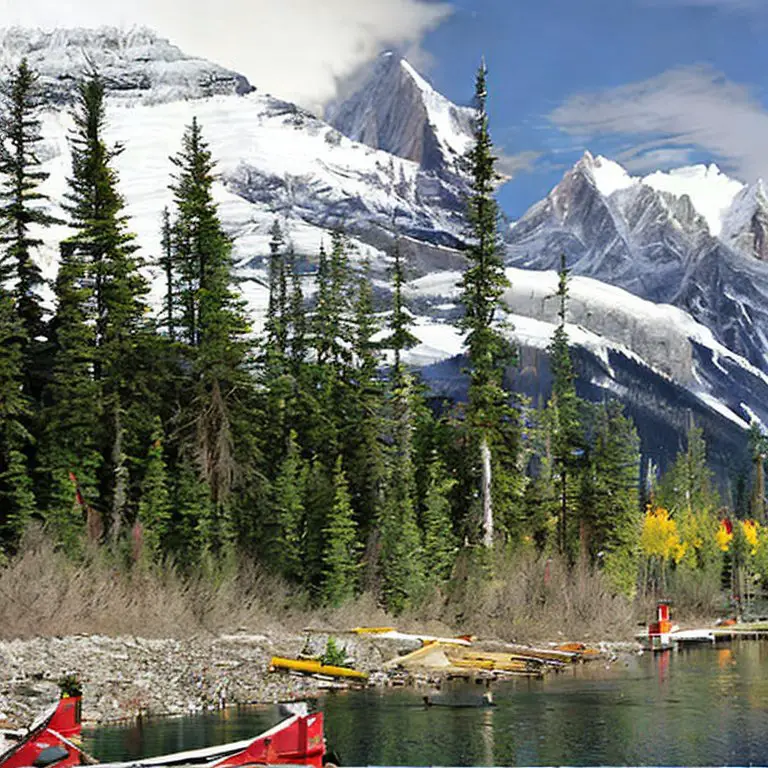Human-environment interaction in Canada refers to the way in which people in Canada interact with and impact their environment, as well as the ways in which the environment shapes and influences human society.
In this post, we will explore the various aspects of human-environment interaction in Canada, including the human impact on the environment, the environmental impact on human society, and efforts toward sustainable development and environmental conservation in the country.
- Human-Environment Interaction Definition
- What is Human-Environment Interaction in Canada?
- Canada’s Climate and Natural Resources
- Negative Human-Environment Interaction in Canada
- Environmental Impact on Human Society in Canada
- Positive Human-Environment Interaction in Canada
- Final Thoughts
Human-Environment Interaction Definition
Human-environment interaction refers to the way in which people interact with and impact their environment, as well as the ways in which the environment shapes and influences human society. This interaction is complex and multifaceted, and includes both positive and negative impacts on both people and the environment.
Human activities, such as the extraction and processing of natural resources, agriculture, and transportation, can have significant impacts on the environment, including deforestation, habitat destruction, and pollution. At the same time, the environment can shape and influence human society in various ways, such as through the availability of natural resources, the impacts of natural disasters, and the influence of climate on human activities.
Understanding and addressing human-environment interaction is important for promoting a healthy and sustainable relationship between humans and the environment. This can involve the implementation of policies and practices that aim to minimize negative impacts on the environment and promote the sustainable use of natural resources, as well as the protection and preservation of natural habitats and wildlife.
You can learn more at Human-Environment Interaction Definition and Human- Environment Interaction Examples.
What is Human-Environment Interaction in Canada?
Human-environment interaction in Canada refers to the way in which people in Canada interact with and impact their environment, as well as the ways in which the environment shapes and influences human society.
Canada’s Climate and Natural Resources
Canada is a country with a diverse climate and a wealth of natural resources. Located in the northern part of North America, Canada spans a wide range of latitudes, which results in a range of climates, from polar to temperate. The country is also home to a diverse range of natural resources, including timber, oil, minerals, and water.
The climate in Canada ranges from polar to temperate, with cold winters and short growing seasons in many parts of the country, and long, hot summers in other parts. This diversity of climate is influenced by various factors, including latitude, altitude, and proximity to large bodies of water. The northernmost parts of Canada have a polar climate, with long, cold winters and short, cool summers, while the southern parts of the country have a more temperate climate, with milder winters and longer, warmer summers.

The polar climate of the northern parts of Canada is characterized by long, cold winters and short, cool summers. This climate is influenced by the country’s high latitude and the fact that it is located in the Arctic Circle. The polar climate is characterized by long, cold winters, with average temperatures ranging from -10 to -20 degrees Celsius. The summers are short and cool, with average temperatures ranging from 5 to 10 degrees Celsius. The polar climate is characterized by low levels of precipitation, with most areas receiving less than 50 cm of precipitation per year.
The temperate climate of the southern parts of Canada is characterized by milder winters and longer, warmer summers. This climate is influenced by the country’s lower latitude, as well as its proximity to large bodies of water, such as the Great Lakes and the Atlantic Ocean. The temperate climate is characterized by mild winters, with average temperatures ranging from 0 to -10 degrees Celsius. The summers are longer and warmer, with average temperatures ranging from 20 to 30 degrees Celsius. The temperate climate is also characterized by higher levels of precipitation, with most areas receiving between 50 and 100 cm of precipitation per year.
In addition to its diverse climate, Canada is also home to a wealth of natural resources, including timber, oil, minerals, and water. The country has a large forestry industry, with forests covering approximately 38% of its land area. These forests are a major source of timber for construction, paper, and other products. The forestry industry is an important contributor to the country’s economy, and employs thousands of people across the country.
Canada is also a major producer of oil, with large reserves in the western provinces of Alberta and Saskatchewan. The country is home to the third-largest oil reserves in the world, and is a major exporter of oil to the United States and other countries. The oil and gas industry is an important contributor to the country’s economy, and employs thousands of people across the country.
Overall, Canada is a country with a diverse climate and a wealth of natural resources, which have played a significant role in shaping the country’s history, economy, and society. These resources have also had both positive and negative impacts on the environment, and it is important for people in Canada to understand and address these impacts through efforts towards sustainable development and environmental conservation.
Negative Human-Environment Interaction in Canada
Human Impact on the Environment in Canada
The human impact on the environment in Canada is significant, as the country relies heavily on the extraction and processing of natural resources, such as timber, oil, and minerals, for various industries. These activities can have negative impacts on the environment, including deforestation, habitat destruction, and pollution.
One of the main sources of human impact on the environment in Canada is the logging industry, which is a major contributor to deforestation in the country. Forests are clear-cut to make way for new logging operations, which can have negative impacts on wildlife and their habitats, as well as contribute to climate change through the release of carbon dioxide from the burning or decomposition of wood.

In addition to logging, other human activities, such as agriculture and transportation, can also contribute to deforestation and habitat destruction. For example, the conversion of forests to agricultural land can lead to the destruction of habitats and the loss of plant and animal species. Transportation infrastructure, such as roads and highways, can also have negative impacts on the environment, including the destruction of habitats and the fragmentation of ecosystems.
The extraction and processing of other natural resources, such as oil and minerals, can also have negative impacts on the environment in Canada. The oil and gas industry, for example, can cause pollution through the release of chemicals and other substances into the air and water. The mining industry can also have negative impacts on the environment, including the destruction of habitats and the release of chemicals and other pollutants into the environment. The extraction and processing of these resources can also contribute to climate change through the release of greenhouse gases, such as carbon dioxide, into the atmosphere.
In addition to the extraction and processing of natural resources, other human activities, such as agriculture, can also have negative impacts on the environment in Canada. Agricultural practices, such as the use of pesticides and fertilizers, can contribute to pollution and the degradation of soil quality. Livestock farming can also have negative impacts on the environment, including the release of methane, a potent greenhouse gas, and the pollution of water sources through the runoff of animal waste.
Overall, the human impact on the environment in Canada is significant, with negative impacts on the environment resulting from the extraction and processing of natural resources, as well as other human activities, such as agriculture and transportation.
Environmental Impact on Human Society in Canada
The environment in Canada has a significant impact on human society, shaping the way people live and work, as well as the types of industries and agricultural practices that are prevalent in different regions. This impact is driven by various factors, including climate, natural disasters, and the availability of natural resources.
One significant aspect of the environmental impact on human society in Canada is the country’s diverse climate, which ranges from polar to temperate. This diversity of climate has shaped the way people live and work, as well as the types of industries and agricultural practices that are prevalent in different regions. For example, the cold winters and short growing season in many parts of Canada limit the types of crops that can be grown, while the long, hot summers in other parts of the country are ideal for certain crops and livestock. The availability of water is also an important factor in the environmental impact on human society in Canada, as certain regions may be more prone to drought or flooding, which can affect agricultural practices and other industries.
In addition to climate, natural disasters, such as floods, wildfires, and earthquakes, can also have significant impacts on human society in Canada. These events can cause destruction of infrastructure and loss of life, as well as disrupt economic and social activities. For example, floods can damage homes and businesses, and disrupt transportation and communication systems, while wildfires can destroy homes and forests, and cause air pollution. Earthquakes can also cause significant damage to infrastructure and loss of life, as well as disrupt economic and social activities.
The availability of natural resources, such as timber, oil, and minerals, is also an important aspect of the environmental impact on human society in Canada. These resources are extracted and processed for use in various industries, and the extraction and processing of these resources can have significant impacts on the environment, including deforestation, habitat destruction, and pollution. For example, the oil and gas industry can cause pollution through the release of chemicals and other substances into the air and water, while the mining industry can have negative impacts on the environment, including the destruction of habitats and the release of chemicals and other pollutants into the environment.
Overall, the environment in Canada has a significant impact on human society, shaping the way people live and work, as well as the types of industries and agricultural practices that are prevalent in different regions. It is important for people in Canada to understand and address these interactions in order to promote a healthy and sustainable relationship between humans and the environment.
Positive Human-Environment Interaction in Canada
Next, we will look at some of the positive efforts being made in Canada towards a better environment and future.
Sustainable Development and Environmental Conservation
Efforts towards sustainable development and environmental conservation in Canada are aimed at promoting the long-term health and well-being of the country’s natural resources and its people. These efforts involve the implementation of policies and practices that aim to minimize negative impacts on the environment and promote the sustainable use of natural resources, as well as the protection and preservation of natural habitats and wildlife.
One example of efforts towards sustainable development in Canada is the use of renewable energy sources, such as hydroelectric and wind power. These sources of energy are clean and renewable, and can help to reduce reliance on fossil fuels, which are a major contributor to climate change. In addition to renewable energy, other efforts towards sustainable development in Canada include the promotion of energy-efficient buildings and transportation, as well as the use of sustainable materials in construction and other industries. For example, the use of energy-efficient buildings can help to reduce energy consumption and greenhouse gas emissions, while the use of sustainable materials, such as recycled materials or biodegradable plastics, can help to reduce waste and pollution.
Conservation efforts are also an important aspect of sustainable development in Canada. These efforts aim to protect and preserve natural habitats and wildlife, and can involve the establishment of protected areas, such as national parks and wildlife reserves. In addition to conservation efforts on land, marine conservation is also important in Canada, as the country has a long coastline and a rich marine environment. Efforts towards marine conservation in Canada include the establishment of marine protected areas and the regulation of activities such as fishing and shipping to minimize negative impacts on the marine environment.
One successful example of conservation efforts in Canada is the country’s network of national parks and protected areas, which covers over 8% of its land area. These protected areas provide habitat for a wide variety of plant and animal species, and are important for the long-term health and well-being of these species and their ecosystems. In addition to protecting natural habitats, conservation efforts in Canada also involve efforts to restore and rehabilitate damaged ecosystems, such as wetlands and streams.
In addition to conservation efforts, there are also various initiatives in Canada aimed at promoting sustainable development and environmental conservation in other sectors, such as agriculture and forestry. For example, the country has implemented policies and practices that aim to reduce the environmental impacts of these industries, such as the use of sustainable farming and forestry practices, as well as the development of alternative products and technologies.
Overall, efforts towards sustainable development and environmental conservation in Canada are important for the long-term health and well-being of the country’s natural resources and its people. These efforts involve the implementation of policies and practices that aim to minimize negative impacts and promote the sustainable use of natural resources, as well as the protection and preservation of natural habitats and wildlife.
Final Thoughts
In conclusion, human-environment interaction in Canada is a complex and multifaceted issue, with both positive and negative impacts on both people and the environment. The human impact on the environment in Canada is significant, with negative impacts resulting from the extraction and processing of natural resources, as well as other human activities, such as agriculture and transportation.
The environment in Canada also has a significant impact on human society, shaping the way people live and work, as well as the types of industries and agricultural practices that are prevalent in different regions.
In order to promote a healthy and sustainable relationship between humans and the environment, it is important for people in Canada to understand and address these interactions through efforts toward sustainable development and environmental conservation. This is done through efforts such as the use of renewable energy, the promotion of energy-efficient practices, and the protection and preservation of natural habitats and wildlife.
Lance has been passionate about the plant-based diet and we have been following a whole food plant-based diet for over 5 years. We focus on health, natural healing, weight management, animal rights, and the health of the planet and environment by focusing on whole plant-based foods and sustainable practices.
Learn more at the About Me page and follow on social media at the links below.


